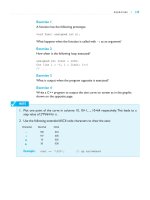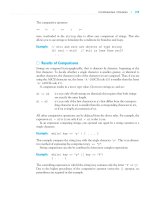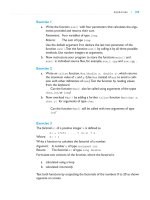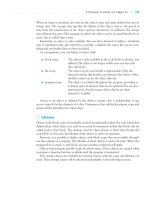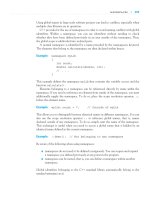A Complete Guide to Programming in C++ part 20 pdf
Bạn đang xem bản rút gọn của tài liệu. Xem và tải ngay bản đầy đủ của tài liệu tại đây (213.76 KB, 10 trang )
SOLUTIONS
■
169
Exercise 2
//
// palindrome.cpp: Reads and compares lines of text.
//
#include <iostream>
#include <string>
using namespace std;
string header = " * * * Testing palindromes * * * ",
prompt = "Enter a word: ",
line( 50, '-');
int main()
{
string word; // Empty string
char key = 'y';
cout << "\n\t" << header << endl;
while( key == 'y' || key == 'Y')
{
cout << '\n' << line << '\n'
<< prompt;
cin >> word;
// Compares the first and last character,
// the second and the second to last etc.
int i = 0, j = word.length() - 1;
for( ; i <= j ; ++i, j)
if( word[i] != word[j] )
break;
if( i > j) // All characters equal?
cout << "\nThe word " << word
<< " is a P A L I N D R O M E !" << endl;
else
cout << "\nThe word " << word
<< " is not a palindrome" << endl;
cout << "\nRepeat? (y/n) ";
do
cin.get(key);
while( key != 'y' && key != 'Y'
&& key != 'n' && key != 'N');
cin.sync();
}
return 0;
}
170
■
CHAPTER 9 THE STANDARD CLASS STRING
Exercise 3
The program outputs the date and time first.Then a greeting is printed
according the time of day. For example:
Date and time: Thu Nov 28 09:01:37 2001
Have a wonderful morning!
171
Functions
This chapter describes how to write functions of your own. Besides the
basic rules, the following topics are discussed:
■ passing arguments
■ definition of inline functions
■ overloading functions and default arguments
■ the principle of recursion.
chapter
10
172
■
CHAPTER 10 FUNCTIONS
C++ program
Core elements of
C++
(built-in types,
operators,
control structures)
Functions and
classes of the
standard library
Self-defined
functions and
classes and
other libraries
■
SIGNIFICANCE OF FUNCTIONS IN C++
Elements of a C++ program
SIGNIFICANCE OF FUNCTIONS IN C++
■
173
C++ supports efficient software development on the lines of the top-down principle. If
you are looking to provide a solution for a more complex problem, it will help to divide
the problem into smaller units. After identifying objects you will need to define classes
that describe these objects. You can use available classes and functions to do so. In addi-
tion, you can make use of inheritance to create specialized classes without needing to
change any existing classes.
When implementing a class you must define the capacities of those objects, that is,
the member functions, in your program. However, not every function is a member func-
tion.
Functions can be defined globally, such as the function main() for example. Func-
tions of this type do not belong to any particular class but normally represent algorithms
of a more general nature, such as the search or sort functions of the standard library.
ᮀ Libraries
You will not need to program each “building block” yourself. Many useful global func-
tions and classes are available from the C++ standard library. In addition, you can use
other libraries for special purposes. Often a compiler package will offer commercial class
libraries or graphical user interfaces. Thus, a C++ program will be made up of
■ language elements of the C++ core
■ global functions and classes from the C++ standard library
■ functions and classes you have programmed yourself and other libraries.
Classes and functions that belong together are normally compounded to form separate
source files, which can be compiled and tested independently. Using software compo-
nents that you have already tested makes programming a complex solution much easier
and improves the reliability of your programs. You can enhance the reusability of your
source code by compiling your own libraries, but be sure to include comments for ease of
readability.
Compiled source files, also known as modules, are compounded by the linker to an
executable file by reference to the libraries you include. If you modify a source file, you
may also need to recompile other files. In large scale projects it is recommended to use
the MAKE utility for module management. An integrated developer environment will
offer the functionality of this utility when you create a new project. This includes your
own source files, the libraries used, and the compiler/linker settings for program com-
pilation.
174
■
CHAPTER 10 FUNCTIONS
// func1.cpp
#include <iostream>
using namespace std;
void test( int, double ); // Prototype
int main()
{
cout << "\nNow function test() will be called.\n";
test( 10, -7.5); // Call
cout << "\nAnd back again in main()." << endl;
return 0;
}
void test(int arg1, double arg2 ) // Definition
{
cout << "\nIn function test()."
<< "\n 1. argument: " << arg1
<< "\n 2. argument: " << arg2 << endl;
}
[type] name([declaration_list]) // Function header
{ // Beginning
.
.
What will be done // Function block
.
.
} // End
■
DEFINING FUNCTIONS
Example of a function definition
General form of a function
DEFINING FUNCTIONS
■
175
The following section describes how to program global functions. Chapter 13, Defining
Classes, describes the steps for defining member functions.
ᮀ Definition
Functions can be defined in any order, however, the first function is normally main.
This makes the program easier to understand, since you start reading at the point where
the program starts to execute.
The function test() is shown opposite as an example and followed by the general
form of a function. The example can be read as follows:
type is the function type, that is, the type of the return value.
name is the function name, which is formed like a variable name
and should indicate the purpose of the function.
declaration_list contains the names of the parameters and declares their
types. The list can be empty, as for the function main(),
for example. A list of declarations that contains only the
word void is equivalent to an empty list.
The parameters declared in a list are no more than local variables. They are created
when the function is called and initialized by the values of the arguments.
Example: When test( 10, -7.5); is called, the parameter
arg1 is initialized with a value of 10 and arg2 with -7.5.
The left curved bracket indicates the start of a function block, which contains the state-
ments defining what the function does.
ᮀ Prototype and Definition
In a function definition the function header is similar in form to the prototype of a func-
tion. The only difference when a function is defined is that the name and declaration list
are not followed by a semicolon but by a function code block.
The prototype is the declaration of the function and thus describes only the formal
interface of that function. This means you can omit parameter names from the proto-
type, whereas compiling a function definition will produce machine code.
176
■
CHAPTER 10 FUNCTIONS
// area.cpp
// Example for a simple function returning a value.
//
#include <iostream>
#include <iomanip>
using namespace std;
double area(double, double); // Prototype
int main()
{
double x = 3.5, y = 7.2, res;
res = area( x, y+1); // Call
// To output to two decimal places:
cout << fixed << setprecision(2);
cout << "\n The area of a rectangle "
<< "\n with width " << setw(5) << x
<< "\n and length " << setw(5) << y+1
<< "\n is " << setw(5) << res
<< endl;
return 0;
}
// Defining the function area():
// Computes the area of a rectangle.
double area( double width, double len)
{
return (width * len); // Returns the result.
}
■
RETURN VALUE OF FUNCTIONS
Defining and calling the function area()
Screen output:
The area of a rectangle
with width 3.50
and length 8.20
is 28.70
RETURN VALUE OF FUNCTIONS
■
177
The program opposite shows how the function area() is defined and called. As previ-
ously mentioned, you must declare a function before calling it. The prototype provides
the compiler with all the information it needs to perform the following actions when a
function is called:
■ check the number and type of the arguments
■ correctly process the return value of the function.
A function declaration can be omitted only if the function is defined within the same
source file immediately before it is called. Even though simple examples often define and
call a function within a single source file, this tends to be an exception. Normally the
compiler will not see a function definition as it is stored in a different source file.
When a function is called, an argument of the same type as the parameter must be
passed to the function for each parameter. The arguments can be any kind of expressions,
as the example opposite with the argument y+1 shows. The value of the expression is
always copied to the corresponding parameter.
ᮀ Return Statement
When the program flow reaches a return statement or the end of a function code block, it
branches back to the function that called it. If the function is any type other than void,
the return statement will also cause the function to return a value to the function that
called it.
Syntax: return [expression]
If expression is supplied, the value of the expression will be the return value. If the
type of this value does not correspond to the function type, the function type is con-
verted, where possible. However, functions should always be written with the return
value matching the function type.
The function area() makes use of the fact that the return statement can contain
any expression. The return expression is normally placed in parentheses if it contains
operators.
If the expression in the return statement, or the return statement itself, is miss-
ing, the return value of the function is undefined and the function type must be void.
Functions of the void type, such as the standard function srand(), will perform an
action but not return any value.
178
■
CHAPTER 10 FUNCTIONS
On call
“push”
On return
“pop”
Stack
further local objects
return address
first parameter
last parameter
• • •
• • •
■
PASSING ARGUMENTS
Calling function and called function
Stack content after calling a function
long func2(int, double); // Prototype
// . . .
void func1()
{
int x = 1.1;
double y;
. . .
long a = func2(x,y); // Call of func2().
. . .
} // Pass by value
long func2(int a, double b) // Definition
{
double x = 2.2;
long result;
. // Here the result
. // is computed.
.
return result;
}

